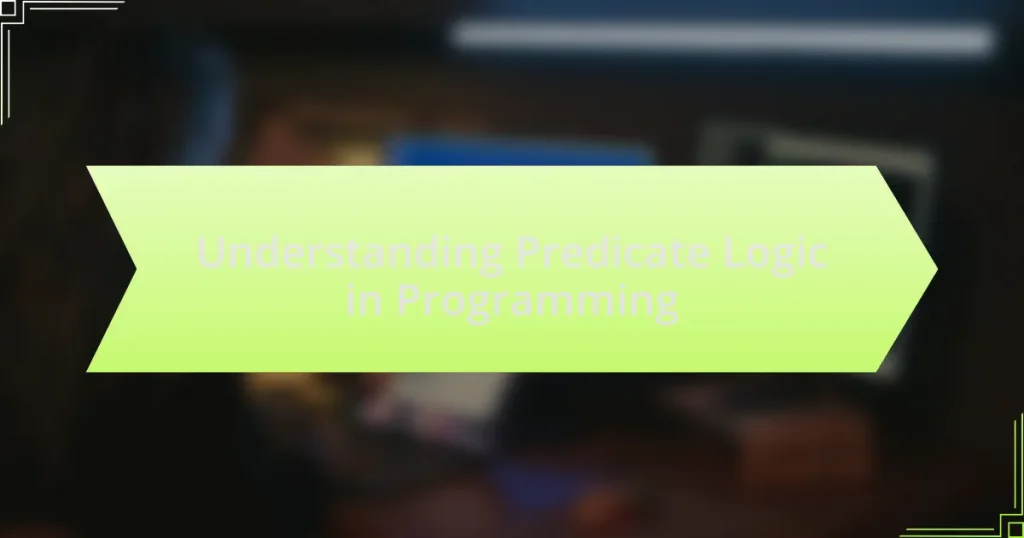Prolog is a high-level programming language that specializes in artificial intelligence and computational linguistics, utilizing formal logic for program execution. This article explores Prolog’s significance in programming, its emergence as a logic programming language in the early 1970s, and the historical context that led to its development. Key figures such as Alain Colmerauer and Philippe Roussel are highlighted, along with the fundamental principles of Prolog, including its unique declarative paradigm and core concepts like facts, rules, and queries. The article also discusses Prolog’s main applications, advantages, limitations, and best practices for coding, providing a comprehensive overview of this pioneering language in logic programming.

What is Prolog and its significance in programming?
Prolog is a high-level programming language primarily associated with artificial intelligence and computational linguistics, characterized by its use of formal logic for program execution. Its significance in programming lies in its ability to facilitate symbolic reasoning and knowledge representation, enabling developers to express complex relationships and rules succinctly. Prolog’s unique approach allows for efficient problem-solving through backtracking and unification, making it particularly effective for tasks such as natural language processing, theorem proving, and expert systems. Historically, Prolog was developed in the early 1970s, and its influence can be seen in various AI applications, demonstrating its enduring relevance in the field of programming.
How did Prolog emerge as a logic programming language?
Prolog emerged as a logic programming language in the early 1970s, developed by Alain Colmerauer and his team in Marseille, France. The language was designed to facilitate natural language processing and artificial intelligence applications, leveraging formal logic as its foundation. Prolog’s syntax and semantics were influenced by the resolution principle and Horn clauses, which are integral to logic programming. The first implementation of Prolog was completed in 1972, marking a significant milestone in the evolution of programming languages focused on logical inference and knowledge representation.
What historical context led to the development of Prolog?
Prolog was developed in the early 1970s as a response to the need for a programming language that could facilitate artificial intelligence research, particularly in natural language processing and theorem proving. The historical context includes the rise of formal logic and symbolic reasoning in computer science, influenced by earlier work in logic programming by John McCarthy and others. The language was created by Alain Colmerauer and his team in France, who aimed to provide a more declarative approach to programming, allowing users to express logic in a way that closely resembles human reasoning. This development was further supported by the growing interest in AI during the 1960s and 1970s, which emphasized the importance of knowledge representation and automated reasoning.
Who were the key figures in the creation of Prolog?
The key figures in the creation of Prolog are Alain Colmerauer and Philippe Roussel. Alain Colmerauer, a French computer scientist, developed Prolog in the early 1970s at the University of Aix-Marseille, focusing on logic programming and artificial intelligence. Philippe Roussel collaborated with Colmerauer, contributing to the language’s development and formalization. Their work laid the foundation for Prolog as a significant programming language in AI and computational linguistics.
What are the fundamental principles of Prolog?
The fundamental principles of Prolog are based on logic programming, specifically the use of facts, rules, and queries to derive conclusions. Prolog operates on a declarative paradigm, allowing users to express knowledge in terms of relationships and logical statements rather than procedural steps. The language employs a resolution-based inference mechanism, which systematically searches for solutions by unifying terms and applying rules. Additionally, Prolog supports backtracking, enabling it to explore multiple potential solutions until it finds one that satisfies the given queries. These principles are foundational to Prolog’s functionality and distinguish it from imperative programming languages.
How does Prolog differ from other programming languages?
Prolog differs from other programming languages primarily in its paradigm, as it is a logic programming language that focuses on formal logic rather than procedural or object-oriented approaches. In Prolog, programs consist of a set of facts and rules that define relationships and allow for inference, enabling the system to derive conclusions from the provided information. This contrasts with languages like Python or Java, which rely on explicit instructions and control flow to execute tasks. The declarative nature of Prolog allows developers to express what the program should accomplish without detailing how to achieve it, which is a fundamental shift from the imperative style of most mainstream programming languages.
What are the core concepts of logic programming in Prolog?
The core concepts of logic programming in Prolog include facts, rules, and queries. Facts represent basic assertions about the world, such as “cat(tom).” Rules define relationships between facts, often in the form of implications, such as “mammal(X) :- cat(X).” Queries allow users to ask questions about the knowledge base, enabling Prolog to infer answers based on the provided facts and rules. These concepts are foundational to Prolog’s operation, facilitating logical reasoning and problem-solving through a declarative programming paradigm.
What are the main applications of Prolog?
Prolog is primarily applied in artificial intelligence, natural language processing, and expert systems. In artificial intelligence, Prolog is used for tasks such as automated reasoning and knowledge representation, enabling systems to infer conclusions from given facts. In natural language processing, Prolog facilitates the development of parsers and language understanding systems due to its ability to handle symbolic reasoning. Additionally, expert systems leverage Prolog for decision-making processes, utilizing its rule-based logic to emulate human expertise in specific domains. These applications demonstrate Prolog’s effectiveness in solving complex problems that require logical deduction and knowledge representation.
In which domains is Prolog most commonly used?
Prolog is most commonly used in artificial intelligence, natural language processing, and expert systems. In artificial intelligence, Prolog facilitates problem-solving and knowledge representation due to its logical inference capabilities. In natural language processing, it aids in parsing and understanding human languages through its pattern-matching features. Additionally, expert systems leverage Prolog for decision-making processes, utilizing its ability to represent complex rules and relationships effectively. These domains highlight Prolog’s strengths in logic-based programming and knowledge representation.
How does Prolog facilitate problem-solving in artificial intelligence?
Prolog facilitates problem-solving in artificial intelligence by providing a declarative programming paradigm that allows users to express logic and relationships through facts and rules. This approach enables efficient querying and reasoning about complex problems, as Prolog’s inference engine can automatically derive conclusions from the given information. For instance, Prolog’s backtracking mechanism systematically explores possible solutions, making it particularly effective for tasks such as natural language processing, expert systems, and constraint satisfaction problems. The language’s foundation in first-order logic ensures that it can represent and manipulate knowledge in a way that aligns closely with human reasoning, thereby enhancing its applicability in AI domains.

What are the key features of Prolog?
Prolog’s key features include its foundation in first-order logic, support for backtracking, and the use of facts and rules for knowledge representation. First-order logic allows Prolog to express complex relationships and queries, making it suitable for tasks like natural language processing and artificial intelligence. Backtracking enables Prolog to explore multiple potential solutions by automatically reverting to previous states when a dead end is reached, enhancing its problem-solving capabilities. Additionally, Prolog’s declarative nature allows users to focus on what to solve rather than how to solve it, streamlining the programming process. These features collectively make Prolog a powerful tool for logic programming and knowledge-based systems.
How does Prolog handle data and knowledge representation?
Prolog handles data and knowledge representation through facts, rules, and queries. In Prolog, facts represent basic assertions about the world, such as “cat(tom).” Rules define relationships and logical implications, for example, “mammal(X) :- cat(X).” Queries allow users to ask questions about the data, enabling Prolog to infer new information based on the existing facts and rules. This logical structure facilitates a declarative programming style, where the focus is on what the program should accomplish rather than how to accomplish it, making Prolog particularly effective for tasks involving complex relationships and reasoning.
What types of data structures are used in Prolog?
Prolog primarily utilizes three types of data structures: facts, rules, and lists. Facts represent basic assertions about data, rules define relationships and logical implications, and lists serve as a fundamental way to group and manipulate collections of data. These structures enable Prolog to perform logical reasoning and facilitate the representation of knowledge in a declarative manner, which is essential for its functionality as a logic programming language.
How does Prolog represent relationships and rules?
Prolog represents relationships and rules using facts and predicates. In Prolog, facts are basic assertions about the world, such as “parent(john, mary),” indicating that John is a parent of Mary. Predicates define relationships and can take multiple arguments, allowing for complex relationships to be expressed. Rules are formulated using implications, structured as “head :- body,” where the head is a conclusion drawn if the body conditions are satisfied. This logical structure enables Prolog to perform inference and query relationships effectively, as demonstrated in various applications like expert systems and natural language processing.
What is the syntax and structure of Prolog programs?
The syntax and structure of Prolog programs consist of facts, rules, and queries. Facts are basic assertions about objects or relationships, written in the form of predicates, such as “parent(john, mary).” Rules define relationships using implications, structured as “head :- body,” indicating that the head is true if the body is true, for example, “grandparent(X, Y) :- parent(X, Z), parent(Z, Y).” Queries are questions posed to the Prolog interpreter, typically starting with a predicate, like “?- parent(john, mary).” This structure allows Prolog to perform logical reasoning and infer new information based on the provided facts and rules.
What are the basic components of a Prolog program?
The basic components of a Prolog program are facts, rules, and queries. Facts represent basic assertions about the world, such as “cat(tom).” Rules define relationships between facts using implications, for example, “mammal(X) :- cat(X).” Queries are questions posed to the Prolog system to retrieve information based on the defined facts and rules, such as “?- mammal(tom).” These components work together to enable logical reasoning and problem-solving in Prolog.
How do facts, rules, and queries work in Prolog?
In Prolog, facts, rules, and queries form the foundational components of its logic programming paradigm. Facts represent basic assertions about the world, such as “cat(tom).” Rules define relationships between facts, typically in the form of implications, like “mammal(X) :- cat(X).” Queries are questions posed to the Prolog system to retrieve information based on the defined facts and rules, such as “?- mammal(tom).” This structure allows Prolog to infer new information by applying rules to existing facts, enabling logical reasoning and problem-solving.
What are the advantages and limitations of using Prolog?
Prolog offers several advantages, including its strong support for symbolic reasoning and its ability to express complex relationships succinctly through rules and facts. This makes Prolog particularly effective for applications in artificial intelligence, natural language processing, and knowledge representation. Its declarative nature allows developers to focus on what the program should accomplish rather than how to achieve it, which can lead to more straightforward and maintainable code.
However, Prolog also has limitations, such as performance issues with large datasets and a steep learning curve for those unfamiliar with logic programming paradigms. Additionally, Prolog’s execution model can lead to inefficiencies in certain types of computations, particularly those requiring extensive backtracking or when compared to imperative programming languages. These factors can restrict its applicability in performance-critical applications.
What benefits does Prolog offer to developers?
Prolog offers several benefits to developers, primarily its ability to facilitate logical reasoning and problem-solving through its declarative programming paradigm. This allows developers to express complex relationships and rules succinctly, making it easier to model problems in fields such as artificial intelligence, natural language processing, and knowledge representation. Additionally, Prolog’s built-in backtracking mechanism enables efficient exploration of possible solutions, which is particularly advantageous in search and optimization tasks. The language’s strong support for symbolic computation further enhances its utility in applications requiring manipulation of abstract data structures.
What challenges might one face when using Prolog?
One challenge faced when using Prolog is its steep learning curve, particularly for those unfamiliar with logic programming paradigms. This difficulty arises because Prolog’s syntax and operational semantics differ significantly from more conventional programming languages, requiring users to adopt a different way of thinking about problem-solving. Additionally, performance issues can occur, especially in large-scale applications, as Prolog’s backtracking mechanism may lead to inefficiencies in search space exploration. Furthermore, debugging can be complex due to the non-linear execution flow, making it harder to trace errors compared to imperative languages. These challenges highlight the need for a solid understanding of Prolog’s unique features and limitations to effectively utilize the language.

How can one get started with Prolog?
To get started with Prolog, one should first install a Prolog interpreter, such as SWI-Prolog, which is widely used and freely available. After installation, beginners can explore the language by reading introductory materials and tutorials, such as “Learn Prolog Now!” which provides a structured approach to understanding Prolog’s syntax and semantics. Engaging in practical exercises, such as solving logic puzzles or implementing simple programs, reinforces learning and helps in grasping Prolog’s unique features, like backtracking and unification.
What resources are available for learning Prolog?
Books, online courses, and tutorials are key resources for learning Prolog. Notable books include “Programming in Prolog” by Clocksin and Mellish, which provides foundational knowledge and practical examples, and “The Art of Prolog” by Sterling and Shapiro, which offers advanced insights and techniques. Online platforms like Coursera and edX feature courses on Prolog, often created by universities, providing structured learning paths. Additionally, websites such as Learn Prolog Now! offer free tutorials and exercises to practice Prolog programming. These resources collectively support learners at various levels, from beginners to advanced users, ensuring a comprehensive understanding of Prolog.
Which online courses or tutorials are recommended for beginners?
For beginners interested in Prolog, recommended online courses include “Learn Prolog Now!” and “Prolog Programming for Artificial Intelligence” on platforms like Coursera and edX. “Learn Prolog Now!” offers a comprehensive introduction with interactive exercises, while “Prolog Programming for Artificial Intelligence” provides insights into applying Prolog in AI contexts. Both courses are structured to facilitate understanding of Prolog’s syntax and logic, making them suitable for newcomers.
What books provide comprehensive insights into Prolog programming?
“Programming in Prolog” by Clocksin and Mellish provides comprehensive insights into Prolog programming, covering fundamental concepts and practical applications. This book is widely regarded as a definitive resource in the field, offering a thorough introduction to logic programming and Prolog’s syntax and semantics. Additionally, “Prolog Programming for Artificial Intelligence” by Ivan Bratko delves into advanced topics, illustrating how Prolog can be applied in AI contexts, thus reinforcing its relevance in modern programming paradigms. Both texts are essential for anyone seeking a deep understanding of Prolog.
What are some best practices for writing Prolog code?
Best practices for writing Prolog code include using clear and descriptive predicate names, structuring code for readability, and employing comments to explain complex logic. Clear predicate names enhance code understanding, while structured code, such as organizing clauses logically, aids in maintenance. Comments serve to clarify the purpose of predicates and the reasoning behind specific implementations, which is crucial in logic programming where the flow of execution can be less intuitive. Additionally, using tail recursion where possible optimizes performance, as Prolog implementations can handle tail-recursive calls more efficiently. Following these practices leads to more maintainable and efficient Prolog code.
How can one optimize Prolog programs for performance?
To optimize Prolog programs for performance, one should focus on efficient data structures, minimize backtracking, and utilize tail recursion. Efficient data structures, such as using difference lists instead of traditional lists, can significantly reduce the overhead of list manipulations. Minimizing backtracking can be achieved by using cuts (the ‘!’ operator) to limit the search space, which prevents unnecessary computations. Tail recursion, when applicable, allows Prolog to optimize memory usage by reusing stack frames, thus improving execution speed. These strategies are supported by empirical evidence showing that well-structured Prolog programs can run orders of magnitude faster than poorly optimized ones, as demonstrated in various performance benchmarks in logic programming literature.
What common pitfalls should be avoided in Prolog development?
Common pitfalls to avoid in Prolog development include improper use of cuts, neglecting to understand backtracking, and failing to optimize predicates. Improper use of cuts can lead to unintended consequences in the logic flow, as cuts can prevent backtracking and limit the search space. Neglecting backtracking can result in inefficient queries, as Prolog relies on this mechanism to explore multiple solutions. Additionally, failing to optimize predicates can lead to performance issues, as unoptimized predicates may cause excessive computation time. These pitfalls can significantly hinder the effectiveness and efficiency of Prolog programs.
What are some practical examples of Prolog applications?
Prolog is utilized in various practical applications, including natural language processing, expert systems, and theorem proving. In natural language processing, Prolog’s ability to handle symbolic reasoning allows for the development of systems that can understand and generate human language. Expert systems, such as medical diagnosis tools, leverage Prolog’s rule-based logic to infer conclusions from a set of known facts. Additionally, Prolog is employed in theorem proving, where it assists in verifying mathematical theorems through logical deduction. These applications demonstrate Prolog’s strengths in symbolic reasoning and knowledge representation.
How can Prolog be used in natural language processing?
Prolog can be used in natural language processing (NLP) primarily for tasks such as parsing, semantic analysis, and knowledge representation. Its logic-based framework allows for the creation of grammars that can interpret and generate natural language, enabling systems to understand sentence structures and meanings. For example, Prolog’s unification mechanism facilitates the matching of linguistic patterns, which is essential in parsing sentences and extracting their grammatical components. Additionally, Prolog’s ability to represent knowledge in the form of facts and rules supports the development of systems that can reason about language, making it a valuable tool in NLP applications.
What role does Prolog play in expert systems development?
Prolog plays a crucial role in expert systems development by providing a powerful framework for knowledge representation and reasoning. Its logic-based syntax allows developers to express complex rules and relationships, enabling the system to infer conclusions from given facts. Prolog’s backtracking mechanism facilitates the exploration of multiple potential solutions, making it particularly effective for problem-solving tasks in expert systems. Historically, Prolog has been utilized in various applications, such as medical diagnosis and natural language processing, demonstrating its versatility and effectiveness in handling domain-specific knowledge.



